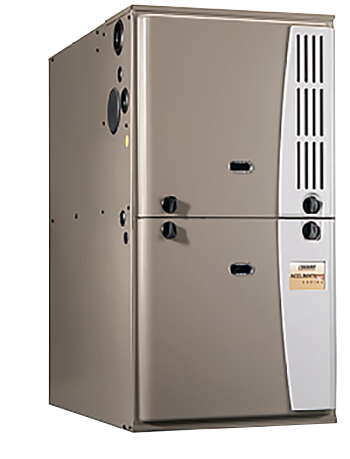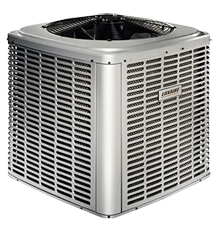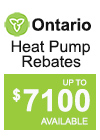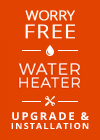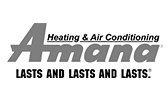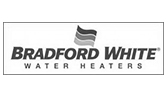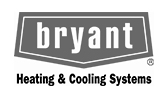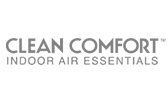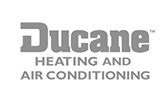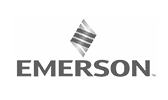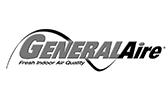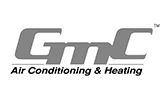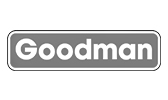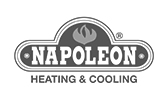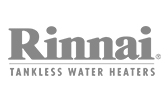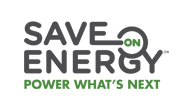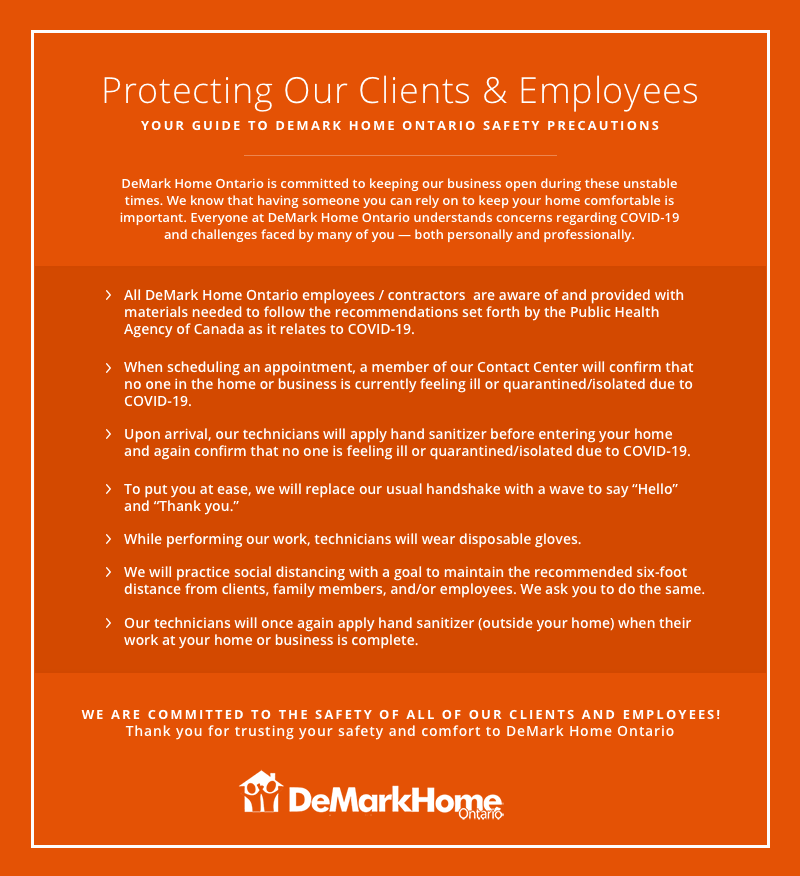Furnace technology has advanced significantly in recent years. Modern furnaces are designed to provide more even and efficient heating than past furnaces, which can impact both how your system operates and what you notice about your system.
To better regulate temperatures and airflow, modern furnaces move more air over the heat exchanger than older furnaces. The air that comes out of your furnace registers may not seem as warm as the air from your old furnace, but overall airflow is improved. Better airflow means higher comfort.
Also, new furnaces are designed to integrate with high-efficiency air conditioners, so furnace blowers are more powerful to accommodate add-on cooling. Since cold air is much heavier than warm air, your system needs an extra boost from the blower to deliver cool air throughout your home. If you have an older home, this performance boost could produce unfamiliar sounds because air duct systems were originally designed for heating only. To minimize sound levels, choose a variable speed product which automatically changes speeds to meet the airflow needs of both heating and cooling cycles.
Furnace technology has advanced significantly in recent years, raising concerns over chimney use. As a result of changing technology, many existing masonry chimneys aren’t able to meet the specific demands of new furnaces.
There are several reasons for this furnace-chimney incompatibility. First, the size of the chimney can be an issue. Modern, higher-efficiency furnaces transfer more heat into your home and less heat up the chimney than older, less-efficient units. While this means more efficiency for your energy dollar, it also means that the existing chimney might be too large for the new furnace. The result could be improper ventilation of flue products, which can cause condensation problems inside the chimney.
Other considerations include chimney height and location, proper lining and condition of the chimney. Building codes must also be kept in mind to ensure proper draft in the chimney for adequate ventilation.
A standard 1″ throw-away furnace filter is between 5-10% particle efficient. This means that across the particle size spectrum, these filters will only trap about 5-10% of what passes through them. You can improve the efficiency of the filtration of your heating and/or cooling system by upgrading to either a media or electronic style filter. Their particle removal efficiencies are 60-65% and 90-95%, respectively and either is quite an improvement over standard 1″ filtration capabilities. By doing an upgrade like this, you will also cut down on maintenance costs on the system as dirty systems are the #1 cause for malfunction. This will also boost the efficiency of the system as the heat and cooling transfer coils will be able to operate with the least amount of resistance.
You should change your standard 1″ furnace filter every 6-8 weeks. Believe it or not, a filter actually becomes more efficient as it get dirtier…up to a point. After peak efficiency is reached, the efficiency drops again. Make sure to inspect the filter and use your own judgment. Don`t let the filter get “clogged” as this can cut down on the efficiency and/or cause damage to the unit.
Since the average person breathes in over 35,000 pints of air a day, all of which is filled with billions of particles of dust, furnace filters clean the air significantly so that the air we breathe is better for us. Furnace filters remove allergens and dust from the air, purifying the air in our homes.
Furnace filters need to be changed several times a year to maintain their benefits. While they don’t necessarily lower your energy bill, the health benefits are numerous, and it has been proven that, over time, a well-maintained furnace with special attention paid to replacing the filter will prolong the life of your furnace and cut down on unnecessary repairs to the blower or mechanisms due to dust damage.
Adjust the louvers inside the registers on the wall or floor in the room where too much heat/cooling is present so that the registers are partially closed. For example, to get more cooling upstairs during hot summer months, partially or fully close the registers downstairs to force more airflow to the upstairs registers.
Another possible solution is a furnace equipped with a variable speed blower motor. These furnaces are designed to overcome airflow problems in a home and will keep the airflow steady all over the home. These types of furnaces also use about 1/3 the electricity of a standard furnace and can save considerable amounts of money in operating costs.
An Arzel zoning system is also a possible solution to this problem. Zoning is the controlled delivery of heated or cooled air to a particular area of the home, without heating and cooling the entire home. Temperatures can be set and maintained independently throughout the home through the use of multiple thermostats.
We recommend 55 degrees. It`s low enough to save you energy and money but warm enough to protect your pipes and other vital parts of your structure. Also, it`s a good idea to turn your main water supply off even if you`re only going to be gone for a day. A water leak could cause serious and very costly damage to your home.
Naturally, you would expect a heating contractor to recommend an annual furnace cleaning as we do. But we do so for a number of reasons. A cleaning means that your furnace will operate more efficiently, getting more heat for your fuel dollar. More importantly, however, the cleaning also includes a thorough safety check of the entire unit for cracked or defective/damaged parts. This annual maintenance check will assure you a carbon monoxide free winter. An annual cleaning is also recommended by all manufacturers as well as utilities.
The arrow should point in the same direction as the air flow. In most cases, it will point towards the furnace and should fit between the return air part of the system and the furnace. The filter screens out the dust and other impurities before the air is warmed in your furnace and then distributed through the duct system.
Always have your system checked annually to make sure that the unit is safe. In many cases, tiny cracks or perforations in the heat exchanger occur. If your furnace is burning inefficiently or incompletely, carbon monoxide can escape and fill the house causing serious health problems and/or death to those inside.
Yes! HVAC systems are mechanical, so like all mechanical systems they do need to be maintained.
High Efficiency’s Precision Tune up gives you these benefits:
- Peace of mind for you and your family
- Lower home heating bills
- Fewer furnace repairs and heating breakdowns
- Priority service scheduling
- Increased Heating capacity
- Extended Furnace and Heating System life
Our Furnace Tune-Up Procedure Includes, As Needed:
- Inspect and tighten all electrical connections and terminals.
- Inspect, clean, and adjust main gas burners.
- Remove, clean, and adjust ignition/pilot assembly.
- Test the capacitor
- Inspect heat-exchanger(s) & combustion chambers for cracks, rusting, or problem areas.
- Vacuum out blower compartment; return airdrop, and surrounding area. (No duct cleaning)
- Inspect the flue assembly and test furnace flue gas drafting mechanism.
- Test and inspect all furnace safety controls.
- Test, and adjust gas pressure.
- Inspect furnace air filters.
- Inspect and clean furnace blower motor, drive mechanism and fan assembly.
- Lubricate all fan motors and all moving parts,as needed
- Measure and adjust blower for correct airflow.
- Adjust and set proper blower speed(s).
- Clean, level, test, and calibrate thermostat.
- Measure and record heating system output.
- Inspect and test thermocouple output as well as pilot safety switch.
- Measure and record electrical voltage, amperage, and component resistance.
- Inspect and test all system transformers, relays, contactors, and controls. Measure performance
- Seal minor air leaks in plenum and return airdrop.
- Perform a thorough, electronic carbon monoxide check of the house.
- Advise customer on other ways to reduce energy consumption, improve safety and enhance comfort.
- Complete and present report.
Your forced-air heating system can perform more efficiently if you:
- Inspect filters once a month and replace as needed during heating season
- Inspect fan belts for cracks
- Make sure vents and air return vents are clear of obstruction
- Check chimney and venting systems once a year for secure fittings, leaks, and no corrosion or damage
- Keep area around furnace clean and clutter-free
- Do not block the source of furnace combustion air by enclosing furnace is a small closet or by making the room it is located in too air tight
Furnaces prior to 1990 were 55% to 65% efficient. The standard furnaces today are 95% efficient. High efficiency furnaces can be up to 97% efficient. A high efficiency furnace can save up to 55% of the heating bill as compared to your old unit. Please contact us and one of our highly trained professionals will be happy to assist you in selecting the right efficiency rating for your home.
Proper sizing is the most important thing in replacing a furnace. Bigger isn’t better. Smaller isn’t cheaper. The best comfort and efficiency is through a properly sized furnace. If the furnace is too small it won’t keep the house at the desired temperature when it is cold outside. If the furnace is too big it heats the house too quickly and then shuts off. This results in hot and cold swings in temperature in the house.
To properly determine the correct size for a furnace please contact one of our professionally trained representatives who will be able to assist you in making the right decision for your home.
The term “variable speed” refers to the furnace’s indoor blower motor, which moves at different speeds to precisely control the flow of heated and cooled air throughout your home. Better airflow control has several benefits:
Electrical efficiency
Variable speed motors can actually save you money on your energy bills, as they consume less electricity than standard motors.
Cooling efficiency
Variable speed technology also means you will gain heating efficiency or AFUE.
Zoning
Variable speed motors are excellent for zoning, which allows you to customize your comfort in different areas of your home and control your energy bills.
Air quality
A variable speed motor can also help clean the air in your home. When the fan is in constant operation (indicated by the “Fan” setting on your thermostat), the motor will continue to slowly circulate air, allowing filters to capture more contaminants.
Humidity control
A variable speed motor combined with a programmable thermostat allows you to control the amount of humidity in your home for improved indoor air quality and comfort
Two-stage heating means the furnace has two levels of heat output: high for cold winter days and low for milder days. Since the low setting is adequate to meet household-cooling demands 80% of the time, a two-stage unit runs for longer periods and provides more even heat distribution. A two-stage furnace has the same concept in mind as a modulating furnace. The difference lies in the fact that while a modulating furnace can operate at any capacity between 40% and 100%, a two-stage furnace operates on a low-stage and a high-stage. The low and high stages have preset BTU outputs. On most days, the furnace will operate at its first stage to only provide the heat you need to stay comfortable. On those very coldest days of the year, this furnace will ramp up to its second stage and give the full BTU output of the furnace to keep satisfying the heating requirements of the home. It`s basically like having two furnaces in one – one for the warmer days and one for the very coldest.
Longer, low-capacity operation has many advantages:
Consistent comfort
Two-stage heating eliminates the temperature swings associated with standard furnaces, regulating temperature to within as little as one degree of the thermostat setting.
Quiet operation
Two-stage furnaces start in the first stage, when the amount of heat required is lower, instead of reaching full capacity all at once. That means there’s no sudden “kick” or blast of air.
Improved air filtration
Low-speed operation allows your filters to capture more contaminants (because air is constantly passing through them), so you can breathe easier.
Efficient performance:
Because the furnace operates mostly in its lower-capacity first stage, it burns less fuel than a standard furnace that always runs at full capacity and shuts off when the heating demand has been high.
Most furnaces are either “off,” providing no heat, or “on” at full capacity, with the burner and blower operating at 100 percent. This causes the temperature in your house to go up and down by several degrees – affecting both your comfort and your energy bills. Furnaces are designed to keep your home warm on the coldest of days. But in most cases, those days account for only 2-1/2 percent of the heating season. The rest of the time, your furnace is providing more heat than is needed to satisfy your comfort requirements. Modulating furnaces solve this problem by “modulating” between different capacities (40-100%), depending on the comfort requirements of the homeowner and the temperature outside. This results in lower operating costs, quieter operation and much more even temperatures throughout the home. It`s like having a separate furnace to handle the unique heating requirements of each day – all in one unit!
The efficiency of a furnace is measured in a rating known as A.F.U.E. (Annual Fuel Utilization Efficiency). A lot like your car’s miles per gallon rating, A.F.U.E. tells you how efficiently the furnace converts fuel (gas, oil or propane) into heat. An A.F.U.E. of 80% means that 80% of the fuel is used to heat your home, while the other 20% basically goes up the chimney.In 1992, the government mandated a minimum A.F.U.E. rating of 78% for furnaces installed in new homes. (In contrast, many furnaces manufactured before 1992 had A.F.U.E. ratings as low as 60% — so nearly half the fuel was being wasted.) Furnaces with A.F.U.E. ratings of 78% to 80% are considered “mid-efficiency”, while those with ratings of 90% or higher are termed “high efficiency.”In general, a higher efficiency furnace usually means two things:
- lower monthly operating costs
- higher comfort levels
If you have an older furnace (10-15 years old with an estimated A.F.U.E. of around 60%), you could save up to 40% on your heating bills by replacing it with a new high-efficiency furnace. So the cost to replace your older, inefficient furnace is paid back through lower utility bills.
You have two choices – you can replace your furnace before it breaks down, or wait till after it breaks down.If you replace it before it breaks down, you can take time to shop for the best deal, and install it on your own timetable. If you wait till after its breaks down (probably on the coldest day in the winter) you are usually in an emergency situation and need to replace it immediately. You may not be able to get the best deal and may have to settle for the first furnace you can get. Therefore, you may want to consider replacing your old furnace before it breaks down.The average 80% standard oil or gas furnace lasts 18 years. Most high efficiency 90%+ furnaces only last 12 years due to their longer run times and design characteristics. It makes sense to have your furnace checked by an HVAC professional every few years. This is especially true for older units. Once you get past the life expectancy of the unit consider planning for a replacement unit.These symptoms can indicate a furnace should be replaced
- Frequent pilot light outages
- Delayed ignition
- Yellow flame or wavering flame
- Excessive soot or corrosion
- Too much or too little heat
- The smell of sulfur or burnt eggs
Questions?
by calling (647) 847-2998 or filling out our easy form.

